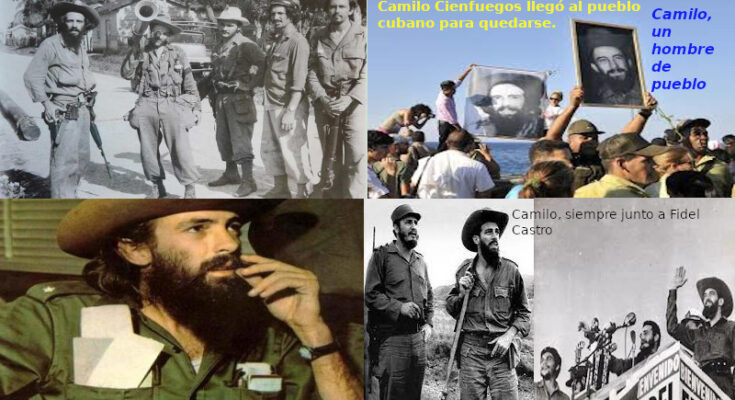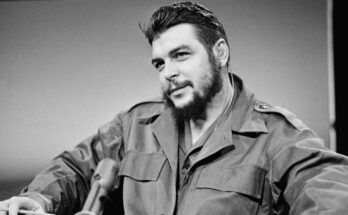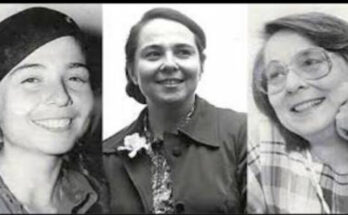The eternal Commander Camilo Cienfuegos Gorriarán lives and will live forever in the heart and work of every Cuban, as a permanent tribute for his exploits during the necessary war and his great contribution to the definitive triumph on January 1st, 1959. Today, 63 years after his physical disappearance, we will remember the Hero of Yaguajay alive and with his legendary smile.
From an early age Camilo had revolutionary restlessness. In 1954, he joined the struggle against the dictatorship of Fulgencio Batista and was registered by the repressive organs, for which he was forced to emigrate to the United States at the age of 21. In 1955 he was arrested and deported to Cuba, joining again the student struggles and being wounded in a protest demonstration.
Imprisoned, tortured and booked by the dictatorial regime’s hired assassins, he had to return to the path of exile. In New York he learned of the project headed by Fidel Castro in Mexico to organize an armed expedition to disembark in Cuba and undertake the armed struggle against the dictatorship.
That enterprise fitted in with his ideals and, after being expelled by the U.S. immigration authorities when his residence permit expired, he left for Mexico on September 19, 1956. Without being sent by any cell of the 26th of July Movement, it was difficult for him to be accepted, which he finally achieved, and on December 2, 1956 he was one of the 82 combatants of the Granma yacht that reached the southern coast of the Orient. After the dispersion of Alegría de Pío he managed to evade the siege, joining Juan Almeida’s group shortly after and on December 18 he managed to regroup with Fidel Castro.
Once in the Sierra Maestra Camilo
joined the José Martí Column 1 under Fidel’s command. On January 17, 1957 he would stand out in the attack on the La Plata barracks and five days later he would do the same in Arroyo del Infierno. A few days later, under the command of Juan Almeida, it would participate in the capture of the traitor Eutimio Guerra, who had been commissioned by the Army to assassinate the leader of the Revolution.
In mid-March 1957, the small guerrilla group received the first large reinforcement in men and weapons sent from the plain by the head of Action and Sabotage of the 26th of July Movement, Frank País García. With this troop the José Martí Column 1 was restructured and three platoons were formed. Camilo was promoted to lieutenant and received the command of the vanguard platoon.
On May 28 he participated in the capture of the Uvero barracks and in the first combat of Pino del Agua, on September 17, he was seriously wounded.
Camilo, the guerrilla leader
After recovering, his recognition as a guerrilla leader increased day by day, which is why in October he joined Commander Ernesto Che Guevara’s Column 4 as leader of the vanguard platoon. As such he would participate in several combats and on December 8 he was promoted to captain.
On February 16, 1958, forces under his command tried to establish an encirclement to annihilate Batista’s army reinforcements in the second combat of Pino del Agua, where he was wounded in the thigh and abdomen.
When it was decided to extend the war to other territories, Camilo Cienfuegos received the mission to lead a platoon in the area of the Cauto River, on March 21, 1958, Camilo became the first guerrilla leader to fight the army of the tyranny outside the natural scenery of the Sierra Maestra.
On April 16, 1958, he was promoted to Commander and promoted to chief of Column 2 Antonio Maceo to operate in the triangle whose vertexes were located in the cities of Bayamo, Manzanillo and Victoria de Las Tunas, as well as the urban areas of these cities.
Once the campaign in the Cauto plains was concluded, other tasks would be entrusted to them before the imminence of the tyranny’s offensive against the Rebel troops in the Sierra Maestra and, by order of Fidel, Camilo returned to the Sierra Maestra leaving a small force in the plains to distract the enemy.
Fidel would make him responsible for the care of the La Plata Command, in addition to participating in several battles such as those of Vega de Jibacoa and Las Mercedes, which defeated the objectives proposed by the military high command of the dictatorial Army.




